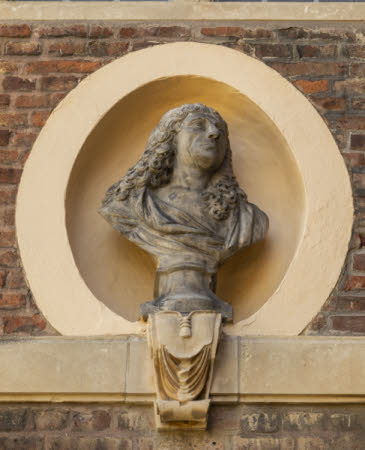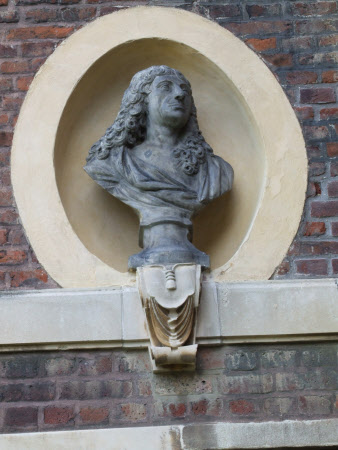Portrait bust of King Charles II (1630-1685)
workshop of John Besnier (fl.1681)
Category
Art / Sculpture
Date
c. 1670 - 1672
Materials
Lead
Place of origin
London
Order this imageCollection
Ham House, Surrey
NT 1140347
Summary
A lead portrait bust of King Charles II (1630-1685), bewigged and wearing loose flowing robes. One of thirty-eight lead busts made for the garden walls of Ham House in 1671-72, perhaps in the workshop of John Besnier, thirty-six of which survive in niches on the walls and on the north façade of the house.
Full description
A portrait bust in lead of King Charles II (1630-1685), depicting the subject turning his head to his left. He is bewigged and is dressed in a loose flowing robe. Mounted on a waisted plinth, and placed on a sandstone console terminating in a scroll and carved with a tab upon which is laid a tassle and from which descends folds of drapery. The portrait of King Charles II, close friend and patron of the Lauderdales, is one of thirty-six lead busts displayed in oval niches in the garden walls and on the north façade of Ham House, probably installed in 1671-72, and recorded in the 1679 inventory of Ham House. The entire series was probably arranged in its present positions along the garden walls and on the north front of Ham House by the 6th Earl of Dysart, as part of improvements undertaken between 1798 and 1803. Almost all the busts are portraits of emperors and other classical male subjects, complemented by a series of female busts. The portraits of Charles II and his father King Charles I (NT 1140348) are therefore exceptional in their depiction of real individuals, with both of whom in this case the Lauderdales were intimately connected. The display of the two busts in some place on the outside of Ham House or its forecourt was a strong demonstration of the family’s loyalty to the Stuart monarchs over several decades. The portrait of Charles does not seem to be derived from other contemporary images of the monarch, such as the marble bust attributed to Caius Gabriel Cibber at Seaton Delaval (NT 1276624). In fact, when compared to the Seaton Delaval portrait or John Bushnell’s terracotta portrait in the Fitzwilliam Museum, Cambridge, the bust at Ham House is remarkable for its studied informality, closer to Edward Pierce’s famous bust of Christopher Wren in the Ashmolean Museum, Oxford, made c. 1673. The long series of lead busts may well, like other sculpture at Ham House, have been made in the workshops of the Besnier family, perhaps by John Besnier, who received a commission for lead statuary from the Duke of Ormonde in 1681. They were originally painted so that they would appear, at least from a distance, to be made of marble. For a fuller discussion of the garden wall busts and their history and attribution, see NT 1140333. Jeremy Warren January 2022
Provenance
Probably made and installed in 1671-72, to the commission of John Maitland and Elizabeth Murray, 1st Duke and Duchess of Lauderdale. Thence by descent, until acquired in 1948 by HM Government when Sir Lyonel, 4th Bt (1854 – 1952) and Sir Cecil Tollemache, 5th Bt (1886 – 1969) presented Ham House to the National Trust. Entrusted to the care of the Victoria & Albert Museum until 1990, when returned to the care of the National Trust, to which ownership was transferred in 2002.
Makers and roles
workshop of John Besnier (fl.1681), sculptor
References
Avery 2013: Charles Avery, ‘Seventeenth-century Sculpture at Ham House’ in Christopher Rowell, ed., Ham House. 400 Years of History, New Haven/London 2013, pp. 158-77., pp. 172-76, fig. 159.


